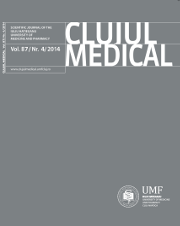Breast diagnosis: Concordance analysis between the BI-RADS classification and Tsukuba sonoelastography score
DOI:
https://doi.org/10.15386/cjmed-362Keywords:
breast, ultrasound, elastography, BI-RADS, TsukubaAbstract
Aims. To establish the correlations between the ultrasound (US) BI-RADS classification and Tsukuba elastography score when assessing breast lesions. To determine which type of breast lesion (BI-RADS category) would benefit most from an elastographic assessment.
Patients and Methods. The investigated sample of imaging comprised a number of 129 images belonging to 92 subjects examined with a Hitachi 8500 US device. Each lesion was assessed according to the BI-RADS and Tsukuba elastography score. Histopathology was obtained by means of percutaneous biopsy or post-surgery. Fibroadenoma-like lesions unchanged over a period of 3 years were considered benign.
Results. The 1, 2 and BGR Tsukuba scores mostly correlated with BI-RADS II and III lesions such as cysts, hamartomas, lipomas, hematomas, non-palpable fibroadenomas. Palpable fibroadenomas initially included in BI-RADS IVa/b category, usually received benign elasticity scores (1 or 2), the exception being represented by a minority of cases of old, fibrotic or calcified lesions (elastic score 3 or 4). Non-specific BI-RADS IVa/b lesions, such as mastopathic nodules demonstrated rather soft, elastic properties on elastogram (score 1 or 2). The 4 and 5 Ueno-Itoh scores were predominantly correlated with BI-RADS IVc and V categories represented by high risk lesions (radial scar, papillomas, atypical epithelial ductal hyperplasia) and in situ or invasive carcinomas.
Conclusions. Generally the BI-RADS classification correlates well with the Tsukuba elasticity score, the main exception being represented by fibrotic, calcified lesions which falsely appear more suspicious post-elastography. BI-RADS III and IV lesions would benefit most from an elastographic assessment, a low Tsukuba score allowing a less invasive approach, while a high score imposes histopathological evaluation.
Downloads
Additional Files
Published
How to Cite
Issue
Section
License
The authors are required to transfer the copyright of the published paper to the journal. This is done by agreeing to sign the Copyright Assignment Form. Whenever the case, authors are also required to send permissions to reproduce material (such as illustrations) from the copyright holder.

The papers published in the journal are licensed under a Creative Commons Attribution-NonCommercial-NoDerivatives 4.0 International License.

